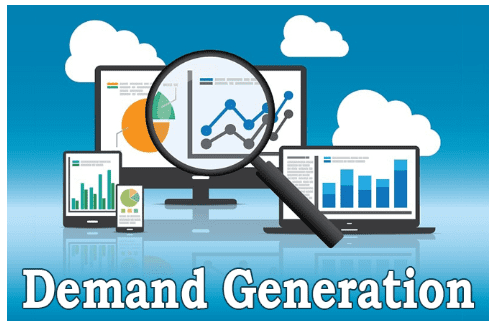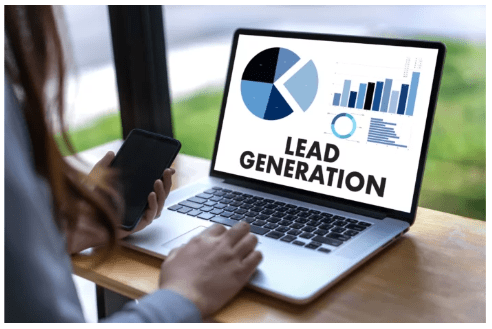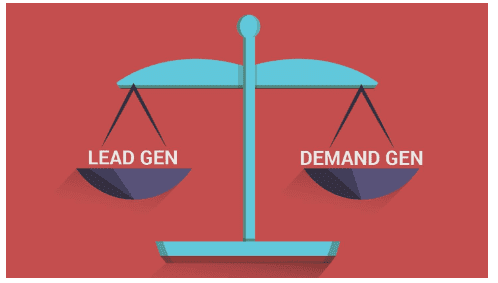Table of Contents
Toggle
Unveiling the Differences: Demand Generation vs. Lead Generation and Their Importance for Your Business
Demand and lead generation are two essential components of a successful business strategy. While they may seem similar, they serve distinct purposes and contribute differently to your business’s growth. Understanding the differences between these two terms is crucial for developing an effective marketing plan.
Demand generation focuses on creating awareness and interest in your products or services among your target audience. It aims to generate a broader demand for your offerings, nurturing prospects and guiding them through the buyer’s journey. Demand-generation strategies often involve content marketing, social media campaigns, and brand-building activities. By providing valuable information, solving pain points, and establishing credibility, demand generation helps you attract potential customers and build a positive reputation.
On the other hand, lead generation is the process of identifying and capturing potential customers who have expressed interest in your products or services. It involves gathering contact information and qualifying leads based on their purchase readiness. Lead generation strategies include landing pages, forms, gated content, and lead magnets. Businesses can collect and nurture leads through targeted marketing efforts by offering value in exchange for contact details.
Both demand generation and lead generation play crucial roles in driving business growth. Demand generation sets the stage by creating awareness, building trust, and establishing your brand as a thought leader in your industry. It focuses on long-term relationship building and nurturing a pipeline of potential customers. Conversely, lead generation helps identify and capture specific individuals more likely to convert into paying customers. It provides a direct avenue to engage with potential buyers and move them closer to making a purchase.
By combining demand and lead generation strategies, businesses can create a holistic approach to marketing and sales. A comprehensive plan encompasses activities that generate awareness, attract prospects, capture leads, nurture relationships, and ultimately convert them into loyal customers. Businesses can optimize their marketing efforts and drive sustainable growth by understanding the differences between demand and lead generation and leveraging their unique benefits.
Understanding Demand Generation
Demand generation is a crucial aspect of marketing that focuses on creating awareness, interest, and demand for your products or services among your target audience. It involves various strategic activities to generate interest and build a pipeline of potential customers.
One of the critical goals of demand generation is to attract and engage a wider audience, including existing customers and new prospects. This is achieved through various channels such as content marketing, social media, advertising, email campaigns, events, etc. By leveraging these channels effectively, businesses can create valuable touchpoints that educate, inform, and inspire their target audience.
Demand generation strategies often revolve around providing relevant and valuable content addressing potential customer’s pain points and challenges. This content can take various forms, including blog posts, whitepapers, case studies, videos, webinars, and infographics. By offering valuable insights, solutions, and thought leadership, businesses can position themselves as industry experts and build trust with their audience.
Furthermore, demand generation efforts typically focus on nurturing prospects throughout the buyer’s journey. This involves guiding them through different stages, from initial awareness to consideration and making a purchase decision. By employing lead nurturing techniques, such as personalized email sequences or targeted retargeting campaigns, businesses can stay engaged with prospects and keep their brand top-of-mind.
Measuring the effectiveness of demand-generation activities is crucial for optimizing marketing efforts. Key performance indicators (KPIs) such as website traffic, engagement metrics, conversion rates, and customer acquisition costs are commonly used to track and evaluate the success of demand-generation campaigns. By analyzing these metrics, businesses can identify areas for improvement and refine their strategies to generate better results.
Demand generation is a comprehensive marketing approach that aims to create awareness, generate interest, and nurture prospects to drive revenue growth ultimately. By employing content marketing, targeted campaigns, and lead nurturing techniques, businesses can attract and engage their target audience, build brand loyalty, and convert prospects into loyal customers.

1.1 Definition and Objectives of Demand Generation
Demand generation refers to the strategic marketing activities undertaken to create awareness, generate interest, and stimulate demand for a product or service among a target audience. It aims to build a pipeline of potential customers and nurture them throughout the buyer’s journey.
The primary objective of demand generation is to attract and engage a broader audience, including new prospects and existing customers. By increasing brand visibility and creating meaningful touchpoints, businesses can generate interest and capture the attention of their target market.
Another objective of demand generation is to educate and inform the audience about the value and benefits of the product or service. By providing valuable content, businesses can address pain points, answer questions, and showcase how their offerings can solve customer problems or improve their lives.
Demand generation also aims to establish and strengthen brand reputation and credibility. Businesses can be trusted experts through thought leadership, industry insights, and compelling storytelling. This helps build trust and confidence among potential customers, making them more likely to consider the brand when purchasing.
Furthermore, demand generation aims to drive customer engagement and interaction. By leveraging various marketing channels, businesses can encourage prospects to take action, such as signing up for newsletters, downloading content, or attending webinars. These interactions create opportunities for companies to capture valuable customer data and initiate further engagement.
Ultimately, the overarching goal of demand generation is to generate qualified leads and drive revenue growth. By attracting and nurturing potential customers, businesses can increase the likelihood of conversion and sales. Effective demand-generation strategies focus on building long-term relationships, leveraging data-driven insights, and aligning marketing efforts with sales objectives.
The objectives of demand generation encompass creating awareness, generating interest, educating the audience, establishing brand credibility, driving engagement, and ultimately driving revenue growth through acquiring qualified leads.
1.2 Key Tactics and Strategies in Demand Generation
Demand generation employs various tactics and strategies to reach and engage the target audience effectively. Here are some key tactics and techniques commonly used in demand generation:
- Content Marketing: Creating and distributing valuable, relevant, and informative content is at the core of demand generation. This includes blog posts, articles, whitepapers, ebooks, videos, infographics, and more. Content helps educate and engage the audience, positioning the business as a trusted resource in their industry.
- Social Media Marketing: Leveraging social media platforms allows businesses to reach a broad audience and engage with potential customers. By sharing content, running targeted ad campaigns, and participating in relevant conversations, companies can build brand awareness and foster engagement.
- Search Engine Optimization (SEO): Optimizing website content for search engines is crucial for improving organic visibility. By conducting keyword research, optimizing meta tags, creating high-quality content, and building backlinks, businesses can enhance their website’s search engine rankings and attract organic traffic.
- Email Marketing: Email campaigns effectively nurture leads and maintain customer relationships. Personalized and segmented email sequences can provide relevant information, offer exclusive promotions, and encourage engagement, leading to conversions and repeat business.
- Webinars and Events: Hosting webinars, workshops, or industry events allows businesses to showcase their expertise, connect with the target audience, and generate leads. These interactive sessions provide valuable insights, engage prospects, and offer opportunities for networking and relationship building.
- Paid Advertising: Paid advertising campaigns, such as search engine marketing (SEM) and display advertising, help businesses reach a broader audience and drive targeted traffic to their website. Pay-per-click (PPC) campaigns enable precise targeting, ensuring ads are displayed to the most relevant audience.
- Lead Magnets and Gated Content: Offering valuable resources such as ebooks, guides, or templates in exchange for contact information is an effective lead generation tactic. By creating gated content, businesses can capture leads and continue nurturing them through email marketing.
- Influencer Marketing: Collaborating with influencers or industry experts with a significant online following can expand your brand’s reach and enhance credibility. Their endorsements and recommendations can generate interest and drive traffic to your business.
- Personalization and Account-Based Marketing (ABM): Tailoring marketing messages and campaigns to specific target accounts or individual prospects increases communication’s relevance and effectiveness. ABM focuses on building personalized relationships with key accounts to generate demand and drive conversions.
- Marketing Automation: Leveraging marketing automation tools and platforms allows businesses to streamline and automate their demand-generation efforts. Automated workflows, lead scoring, and personalized nurture sequences ensure timely and relevant prospect interactions, improving conversion rates.
These tactics and strategies, when implemented effectively, can help businesses generate demand, attract qualified leads, nurture relationships, and drive revenue growth. It’s important to continuously analyze data, measure campaign performance, and refine strategies to optimize the impact of demand generation efforts.

1.3 Importance of Demand Generation
Demand generation plays a crucial role in the overall success of a business. Here are some key reasons highlighting the importance of demand generation:
- Creating Awareness: Demand generation activities are essential for creating awareness about a business, its products, and its services. By reaching a broader audience through various marketing channels, companies can increase brand visibility and ensure their offerings are on the radar of potential customers.
- Generating Interest: Demand generation strategies help create interest and curiosity among the target audience. By providing valuable content, addressing pain points, and showcasing the unique selling points of their offerings, businesses can capture the attention and interest of potential customers.
- Building Brand Reputation: Effective demand generation efforts contribute to building a solid brand reputation. By consistently delivering valuable content, thought leadership, and engaging experiences, businesses can establish themselves as trusted experts in their industry. This enhances credibility and fosters a positive perception of the brand among potential customers.
- Nurturing Relationships: Demand generation focuses on nurturing relationships with prospects throughout the buyer’s journey. Businesses can build trust and strengthen connections with potential customers by providing relevant information, personalized interactions, and timely follow-ups. This leads to increased engagement and higher chances of conversion.
- Generating Qualified Leads: Demand generation helps businesses attract and generate qualified leads. Companies can identify individuals genuinely interested in their offerings by implementing targeted strategies and tactics. These qualified leads are more likely to convert into customers, resulting in a higher return on investment (ROI).
- Supporting Sales Efforts: Effective demand generation aligns marketing efforts with sales objectives. By providing the sales team with a steady stream of qualified leads and nurturing prospects throughout the sales funnel, demand generation enhances the efficiency and effectiveness of the sales process. This leads to increased conversion rates and revenue growth.
- Driving Revenue Growth: Ultimately, demand generation contributes to revenue growth. By consistently attracting and engaging potential customers, businesses can increase their chances of conversions and sales. A well-executed demand generation strategy can significantly impact the bottom line, driving sustainable business growth.
- Competitive Advantage: Demand generation is essential for gaining an edge in today’s competitive business landscape. By effectively reaching and engaging the target audience, businesses can differentiate themselves from competitors, establish brand loyalty, and capture market share.
Demand generation is of utmost importance for businesses as it creates awareness, generates interest, builds brand reputation, nurtures relationships, generates qualified leads, supports sales efforts, drives revenue growth, and provides a competitive advantage. By investing in strategic demand-generation activities, businesses can effectively attract and engage potential customers, positioning themselves for long-term success.
Understanding Lead Generation
Lead generation refers to identifying, attracting, and capturing potential customers or leads interested in a business’s products or services. It involves tactics and strategies to gather contact information and qualify leads based on their likelihood to purchase.
The primary objective of lead generation is to build a database of individuals who have expressed interest in the business and are potential customers. These leads can be further nurtured and guided through the sales funnel toward conversion.
Lead generation tactics encompass a variety of activities, including:
- Landing Pages: Creating dedicated landing pages with compelling offers or lead magnets to capture visitor information, such as email addresses or phone numbers. These pages are designed to entice visitors to take a specific action, such as signing up for a newsletter or requesting a demo.
- Forms and Opt-in Opportunities: Placing conditions strategically on websites or within the content to collect lead information. Opt-in opportunities, such as checkboxes for newsletter subscriptions, enable businesses to gather leads while providing value to the audience.
- Gated Content: Requiring visitors to provide contact details to access valuable content, such as ebooks, whitepapers, or exclusive reports. This strategy encourages lead generation while positioning the business as a trusted source of expertise.
- Lead Magnets: Offering incentives, such as free trials, discounts, or downloadable resources, to motivate visitors to share information. Lead magnets entice prospects to take action and provide their contact details in exchange for something valuable.
- Webinars and Events: Hosting webinars or events and requiring registration to participate. This allows businesses to capture contact information from interested attendees, who can be nurtured further through targeted follow-ups.
- Content Marketing: Creating informative, engaging, and shareable content that drives traffic to the business’s website. Content marketing positions the company as a valuable resource, attracting potential customers interested in the topics covered.
- Social Media Lead Generation: Leveraging social media platforms to engage with the audience and capture leads. Tactics may include running contests, using lead-generation ads, or providing gated content directly on social media platforms.
- Referral Programs: Encouraging existing customers to refer their friends, colleagues, or contacts to the business. Referral programs incentivize referrals and tap into existing customers’ networks to generate leads with a higher potential for conversion.
Effective lead generation requires a comprehensive strategy that captures leads, nurtures relationships through targeted communication, and aligns marketing efforts with sales objectives. By employing these tactics and strategies, businesses can attract interested prospects, gather valuable contact information, and guide leads toward becoming paying customers.

2.1 Definition and Objectives of Lead Generation
Lead generation refers to identifying and capturing potential customers or leads interested in a business’s products or services. It involves various marketing tactics and strategies to gather contact information and qualify leads based on their likelihood to convert into paying customers.
The primary objective of lead generation is to build a pipeline of qualified leads. These leads have expressed interest in the business by taking a specific action or demonstrating a need for the product or service. By capturing their contact information, such as email addresses or phone numbers, businesses can initiate targeted communication and nurture these leads toward making a purchase.
Lead generation strategies focus on engaging with the target audience, attracting their attention, and motivating them to take action. The objectives of lead generation include:
- Capturing Prospects: The initial goal of lead generation is to capture the contact information of potential customers. This includes gathering email addresses, phone numbers, or other relevant details that allow businesses to initiate further communication and follow-up.
- Qualifying Leads: Lead generation also involves evaluating and qualifying leads based on their level of interest, readiness to purchase, or alignment with the business’s target customer profile. Qualification criteria may include demographics, interests, behavior, or specific actions the leads take.
- Nurturing Relationships: Once leads are captured, the objective is to nurture the relationship and build trust with them over time. This is typically achieved through targeted and personalized communication, providing valuable information, addressing their pain points, and guiding them through the buyer’s journey.
- Increasing Conversion Rates: The ultimate goal of lead generation is to convert leads into paying customers. By implementing effective lead nurturing strategies, businesses aim to increase the conversion rates of their leaders, maximizing the return on investment (ROI) of their marketing efforts.
- Supporting Sales Efforts: Lead generation supports the sales process by providing the sales team with a steady stream of qualified leads. By delivering well-qualified leads, businesses can enhance the efficiency and effectiveness of their sales efforts, ultimately driving revenue growth.
- Building Customer Loyalty: Lead generation is focused on acquiring new customers and fostering customer loyalty. By nurturing relationships with leads which have become customers, businesses can turn them into repeat buyers and brand advocates, contributing to long-term success.
Lead generation objectives encompass capturing prospects, qualifying leads, nurturing relationships, increasing conversion rates, supporting sales efforts, and building customer loyalty. By implementing effective lead generation strategies, businesses can attract and engage potential customers, nurture them through the sales funnel, and ultimately drive revenue growth and customer loyalty.
2.2 Key Tactics and Strategies in Lead Generation
Lead generation is a crucial aspect of any business or marketing strategy. It involves attracting and capturing potential customers’ interest in your products or services and nurturing them into becoming qualified leads. Here are some key tactics and strategies commonly used in lead generation:
- Content Marketing: Creating valuable and relevant content is an effective way to attract and engage potential leads. This can include blog posts, articles, e-books, videos, webinars, and infographics. By providing helpful information, you can position yourself as an industry expert and build trust with your target audience.
- Landing Pages and Forms: A landing page is a dedicated web page that captures visitor information. It typically includes a lead capture form where visitors can provide their contact details in exchange for a valuable resource, such as a whitepaper or a free trial. Optimizing landing pages and documents for conversion is essential to maximize lead generation.
- Search Engine Optimization (SEO): Optimizing your website and content for search engines helps improve your visibility and organic traffic. By targeting relevant keywords, optimizing meta tags, and creating high-quality content, you can attract more potential leads actively searching for solutions or information related to your business.
- Email Marketing: Email marketing remains a powerful tool for lead generation. By building an email list of interested prospects, you can regularly communicate with them, provide valuable content, promote offers, and nurture leads throughout their buyer’s journey. Personalization and segmentation of email campaigns can improve their effectiveness.
- Social Media Marketing: Leveraging social media platforms like Facebook, Twitter, LinkedIn, or Instagram can help expand your reach and engage with potential leads. Sharing relevant content, participating in discussions, and running targeted ad campaigns can attract followers, generate interest, and drive traffic to your website or landing pages.
- Paid Advertising: Paid advertising channels, such as Google Ads or social media advertising platforms, can help quickly generate leads. Pay-per-click (PPC) campaigns allow you to target specific demographics, interests, or search terms, ensuring potential leads see your ads. Effective ad copy and compelling offers are crucial for driving conversions.
- Webinars and Events: Hosting webinars or participating in industry events and trade shows can be effective lead-generation tactics. These platforms provide opportunities to showcase your expertise, engage with your target audience, and capture leads through registration forms or networking.
- Referral Programs and Customer Advocacy: Encouraging satisfied customers to refer your business to their networks can be a powerful source of leads. Implementing referral programs or creating customer advocacy initiatives that incentivize referrals can amplify your lead-generation efforts.
- Lead Nurturing: Once you’ve captured leads, nurturing them throughout their buying journey is essential. Using marketing automation tools, you can send targeted and personalized content based on their interests and behaviors, gradually building trust and guiding them toward purchasing.
- Continuous Tracking and Optimization: Regularly tracking and analyzing key metrics and performance indicators allows you to identify what’s working and make data-driven improvements. A/B testing landing pages, email subject lines, ad creatives, and other elements of your lead generation campaigns can help optimize their effectiveness.
Remember, lead generation is an ongoing process that requires a combination of these tactics and strategies tailored to your target audience and industry. By implementing a comprehensive lead generation strategy and adapting it based on insights and feedback, you can generate a steady stream of qualified leads to support your business growth.

2.3 Importance of Lead Generation
Lead generation plays a crucial role in the success and growth of any business. Here are some reasons why lead generation is essential:
- Business Growth: Lead generation is a crucial driver of business growth. By consistently generating new leads, you increase your chances of converting them into customers. More customers mean more revenue and opportunities for expansion.
- Sales Pipeline: Lead generation feeds your sales pipeline with potential prospects. You ensure a healthy pipeline that keeps your sales team busy and engaged by continuously adding new leads. A robust pipeline increases the likelihood of closing deals and achieving sales targets.
- Targeted Marketing: Lead generation allows you to target specific audience segments or ideal customer profiles. By identifying and focusing on your target market, you can tailor your marketing messages and offers to resonate with their needs and pain points. This leads to higher conversion rates and more effective marketing campaigns.
- Customer Acquisition Cost (CAC): Lead generation helps optimize customer acquisition costs. By nurturing and converting leads, you can reduce your CAC by minimizing the resources spent on acquiring new customers. Compared to traditional advertising or cold outreach methods, lead generation often provides a more cost-effective approach.
- Relationship Building: Lead generation is not only about acquiring customers but also about building relationships. You can establish trust and credibility with your leads by providing valuable content, personalized experiences, and timely follow-ups. Strong relationships increase the likelihood of conversion and foster long-term customer loyalty.
- Data Insights: Lead generation provides valuable data and insights about your target audience. You better understand your market by tracking and analyzing lead behavior, demographics, preferences, and interactions. This data helps refine your marketing strategies, personalize your messaging, and make data-driven decisions.
- Competitive Advantage: Effective lead generation gives you a competitive edge. By proactively reaching out to potential customers and building relationships, you stay ahead of competitors who may rely solely on passive marketing or wait for customers to approach them. Being proactive and engaging with leads positions you as a trusted industry leader.
- Business Stability: Consistent lead generation contributes to the stability and sustainability of your business. You mitigate risks and potential downturns by diversifying your lead sources and reducing dependence on a limited customer base. A steady flow of leads ensures a constant pool of potential customers, even during challenging times.
- Referral Opportunities: Satisfied customers generated through lead-generation efforts can become powerful advocates for your business. They are likelier to refer your products or services to others, generating additional leads through word-of-mouth. This organic growth through referrals is a valuable outcome of effective lead generation.
- Adaptability and Innovation: Lead generation requires continuous adaptation and innovation. As you experiment with different tactics and strategies, you stay ahead of market trends and customer preferences. This agility helps your business evolve and adapt to changing circumstances, ensuring long-term success.
Lead generation is vital for business growth, sales pipeline management, targeted marketing, relationship building, cost optimization, data insights, competitive advantage, stability, referral opportunities, and adaptability. By prioritizing lead generation efforts, businesses can thrive in a competitive marketplace and achieve sustainable growth.
Integration and Interdependency
Integration and interdependency relate to the interconnectedness and interrelationship between different elements or entities. They can be applied to various fields, including economics, politics, technology, and society.
Let’s explore these concepts in more detail:
Integration: Integration refers to combining separate parts or elements into a unified whole. It involves coordinating and harmonizing different components to create a cohesive system.
Integration can occur at various levels, such as:
- Economic Integration: This involves merging economies or establishing closer economic cooperation between countries. Examples include regional trade agreements like the European Union (EU) or the North American Free Trade Agreement (NAFTA).
- Technological Integration: In the context of technology, integration refers to the interoperability and seamless functioning of different systems or devices. For instance, integrating various software applications to streamline processes within a business.
- Social Integration: Social integration refers to the inclusion and participation of individuals from diverse backgrounds within a society. It aims to create a cohesive and harmonious social fabric by reducing divisions and promoting understanding.
- Interdependency: Interdependency signifies the mutual reliance and interconnectedness between different entities or systems. It recognizes that the actions or decisions of one element can have an impact on others.
Critical aspects of interdependency include:
- Economic Interdependency: In a globalized world, economies are often highly interdependent. Changes in one country’s economy can have ripple effects on others due to trade relationships, financial connections, or supply chain dependencies.
- Political Interdependency: Political interdependency refers to the notion that countries or regions rely on each other politically. Decisions made by one nation can affect others, and international cooperation becomes essential for addressing global challenges like climate change, security threats, or pandemics.
- Technological Interdependency: Technological systems and networks are often interdependent. Disruptions or failures in one component can impact the functioning of others. For example, a cyber attack on critical infrastructure can have cascading effects on various sectors.
- Social Interdependency: Individuals and communities are socially interdependent as well. The people around us influence our actions, decisions, and well-being. Social interdependency recognizes the need for collaboration, empathy, and support within societies. Both integration and interdependency can have positive and negative implications.
On the one hand, they can foster cooperation, collective problem-solving, and efficiency. On the other hand, they can also create vulnerabilities, risks, and challenges that require careful management and coordination. Striking a balance between integration and maintaining resilience in the face of interdependencies is crucial for sustainable development and stability.

Final Thoughts
Integration and interdependency are fundamental aspects of our interconnected world. They exist in various domains, including economics, politics, technology, and society. Embracing integration allows for the creation of cohesive systems through economic cooperation, technological interoperability, or social inclusion.
Interdependency highlights the mutual reliance and interconnectedness between different entities, emphasizing the need for collaboration and recognizing the impact of our actions on others.
While integration and interdependency offer numerous benefits, they also present challenges and risks. Overreliance on interconnected systems can make us vulnerable to disruptions or failures, and the unequal distribution of benefits from integration can lead to disparities and conflicts. Balancing integration and maintaining resilience is crucial, considering the benefits and potential risks involved.
Effective communication, cooperation, and coordination are essential to navigate the complexities of integration and interdependency. Building strong relationships and fostering trust among stakeholders at various levels can help address challenges, mitigate risks, and maximize the benefits of integration.
Recognizing and understanding the dynamics of integration and interdependency in an increasingly interconnected world is crucial. By promoting inclusive and sustainable development, managing risks, and embracing cooperation, we can harness the potential of integration and interdependency for the betterment of individuals, societies, and the global community.
- Success vs. Significance: Understanding the Difference and Achieving Both - October 1, 2023
- 8 Steps to SaaS Success: From Idea to Business - September 30, 2023
- The Importance of Testing in SaaS: Ensure Quality and Success - September 29, 2023